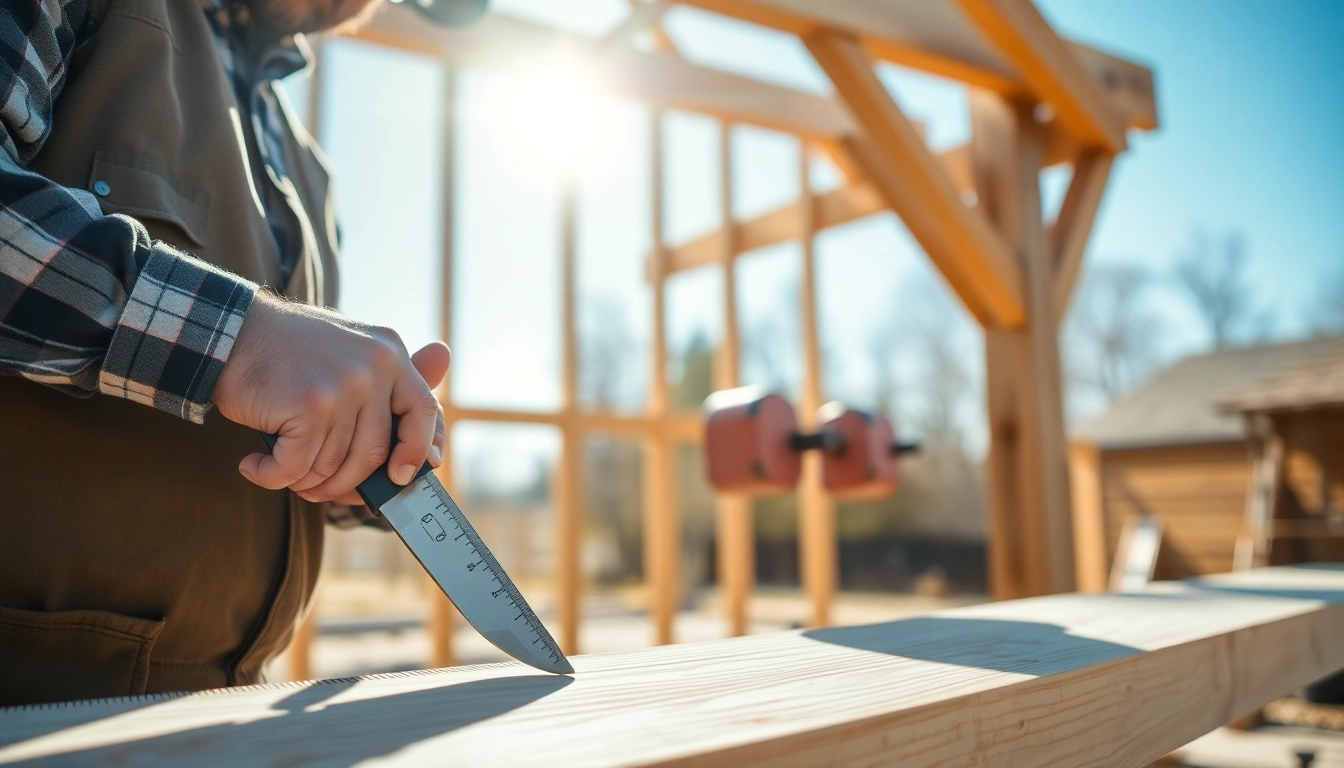Understanding the Role of a Carpenter in Modern Construction
The role of a Carpenter is fundamental to the development of both residential and commercial structures. Carpenters construct, repair, and install building frameworks, ensuring that structures are safe, functional, and aesthetically pleasing. Their expertise is vital throughout every phase of construction—from initial framing to finish carpentry—making them indispensable in the construction industry. As modern architecture continues to evolve with innovative materials and building techniques, the role of carpenters also adapts, blending traditional craftsmanship with cutting-edge technologies. Whether working on traditional timber frameworks or integrating sustainable materials, carpenters are at the forefront of creating both durable and beautiful structures.
According to the Occupational Outlook Handbook, the primary responsibilities of carpenters involve constructing, repairing, and installing a variety of building frameworks made from wood and other materials. This includes residential homes, commercial buildings, bridges, and other infrastructures. Their work often requires specialized skills in blueprint reading, measurement, and material handling, alongside a keen eye for detail and craftsmanship. With ongoing developments in construction methods and an increased focus on sustainability, the modern carpenter’s skill set is more diverse than ever. This makes the profession both challenging and rewarding, offering opportunities for those who seek a career that combines technical skill with creative problem solving.
Types of Carpenters and Specializations
Carpentry is a broad trade encompassing various specializations, each requiring unique skills and tools. Understanding these categories helps homeowners, builders, and aspiring carpenters identify the most suitable career path or service requirement.
1. Rough Carpenters
Rough carpenters focus on the structural framework of buildings—constructing the skeleton that supports the entire structure. They work on framing walls, floors, roofs, and foundations, often in the early stages of construction. Their work demands precision measurement, understanding of building codes, and physical endurance. For example, framing a multi-story building involves extensive calculations, material handling, and teamwork.
2. Finish Carpenters
Finish carpenters are responsible for the detailed and aesthetic aspects of a project. They install trim, molding, cabinetry, doors, and window frames, ensuring a high level of craftsmanship and visual appeal. Finish carpenters often work after the rough framing is complete and need excellent attention to detail, knowledge of finishing techniques, and proficiency with tools like routers, saws, and chisels.
3. Residential Carpenters
Specializing in home construction and remodeling, residential carpenters work on everything from minor repairs to large-scale renovations. Their work includes installing cabinetry, decks, stairs, and custom woodwork tailored to individual client specifications.
4. Commercial Carpenters
Commercial carpenters focus on larger-scale projects such as office buildings, shopping centers, and industrial complexes. They often follow precise architectural plans and collaborate closely with project managers to meet tight deadlines and compliance standards.
5. Industrial and Steel Frame Carpenters
Working with steel frameworks and industrial settings, these carpenters require knowledge of metalworking and specialized safety standards. They often collaborate with engineers and fabricators to erect durable structures that withstand extreme conditions.
6. Specialty Carpenters
This category includes cabinetmakers, scaffolding installers, and even restoration specialists. Each subfield demands unique skills and often involves working with niche materials or historic preservation standards.
Key Skills and Qualifications for Carpenters
Successful carpenters possess a blend of technical expertise, physical dexterity, and problem-solving ability. Crucial skills include:
- Blueprint and schematic reading – to interpret design plans accurately.
- Mathematical proficiency – for precise measurements and calculations.
- Material knowledge – understanding different woods, composites, and modern materials.
- Tool mastery – safe and efficient use of hand tools, power tools, and machinery.
- Physical strength and stamina – to handle heavy materials and perform physically demanding tasks.
- Attention to detail – ensuring precision in cuts and installation.
- Problem-solving skills – to adapt to site conditions and unforeseen issues.
Many carpenters gain experience through apprenticeships, which combine on-the-job training with classroom instruction. Certification from recognized bodies such as the National Association of the Remodeling Industry (NARI) or OSHA safety standards enhances credibility and career advancement prospects.
A strong educational background, coupled with specialized certifications, increases employability and earning potential. As the industry leans toward sustainable practices, knowledge of green building techniques and eco-friendly materials further distinguishes a skilled carpenter.
Typical Projects and Work Environments
Carpenters work in diverse environments, each with its unique challenges and requirements. Typical projects include:
- Residential construction: framing new homes, installing cabinetry, hardwood flooring, and finish carpentry work.
- Commercial projects: building structural frameworks, installing partitions, ceilings, and specialized fixtures.
- Remodeling and renovations: updating kitchens, bathrooms, or entire interiors.
- Industrial settings: fabricating steel frameworks and specialized structures.
The worksite can range from outdoor job sites exposed to weather extremes to indoor commercial spaces with tight deadlines. Carpenters often collaborate with architects, project managers, electricians, plumbers, and other tradespeople to ensure integrated and efficient workflows. Flexibility, adaptability, and safety awareness are crucial traits for navigating these varied environments.
The use of modern technology, such as laser measuring devices, CAD software, and modular construction methods, enhances accuracy and efficiency on the job. Staying current with evolving construction methods and safety standards ensures quality and reduces project delays.
How to Choose the Right Carpenter for Your Needs
Important Considerations and Questions to Ask
Selecting a skilled and reliable carpenter requires thorough planning. Key questions include:
- Are they licensed and insured? Confirming licensing and insurance protects against liability and ensures compliance with local regulations.
- What is their experience with similar projects? Ask for examples or references.
- Do they provide detailed estimates? Clarify scope, materials, timeline, and payment terms.
- Are they familiar with current building codes and safety standards?
- Can they provide a timeline for project completion?
Evaluating Experience and Portfolio
Review their portfolio of past work, including photos and client testimonials. Visit completed projects if possible to assess craftsmanship and attention to detail. Professional carpenters often showcase their work on websites or social media, offering insight into their specialization and quality.
Estimating Costs and Timeline Expectations
Obtaining multiple quotes allows for comparison of pricing and scope. Be wary of significantly lower bids, which may compromise quality. Clear communication about the project timeline helps set realistic expectations and aligns schedules to prevent delays.
Proper planning and due diligence ensure your investment yields durable, high-quality results and peace of mind.
Best Practices in Carpentry: From Planning to Finish
Design and Blueprint Reading
Effective carpentry begins with a thorough understanding of architectural plans. Mastering blueprint reading involves interpreting measurements, symbols, and specifications accurately. Modern carpenters often utilize CAD software for precise design modeling, enabling better planning and material estimation.
Material Selection and Sustainability
The choice of materials influences the durability, appearance, and environmental impact of a project. Sustainable options include reclaimed wood, bamboo, and low-VOC paints. Knowledge of eco-friendly materials and construction techniques is increasingly essential as clients and regulations emphasize green building practices.
Safety Standards and Quality Assurance
Safety remains paramount in carpentry. Adherence to OSHA regulations, proper use of personal protective equipment, and ongoing safety training minimize workplace accidents. Quality assurance involves rigorous inspection at each stage, ensuring precision and compliance with building codes. Documenting quality checks fosters accountability and client trust.
Maximizing Your Investment with Professional Carpentry
Benefits of Hiring Certified Carpenters
Certified carpenters demonstrate high levels of skill, reliability, and adherence to industry standards. Certification often correlates with better project outcomes, fewer delays, and superior craftsmanship. It assures clients of their investment’s long-term value and structural integrity.
Maintenance and Long-Term Durability
Proper maintenance extends the lifespan of carpentry work. Regular inspections, cleaning, and timely repairs prevent deterioration. For example, sealing wood surfaces reduces moisture damage, and inspecting joinery ensures continued stability and safety.
Innovative Technologies in Carpentry
Advancements such as CNC machinery, 3D modeling, and laser-guided tools have transformed carpentry. These innovations improve accuracy, reduce waste, and accelerate project timelines. Embracing new technology enhances competitiveness and quality in a rapidly evolving industry.
Performance Metrics and Trends in the Carpentry Industry
Current Salary Expectations and Job Outlook
The median hourly rate for carpenters ranges from $75 to $125, with annual salaries reaching up to $85,500 for top-tier roles. Skilled and specialized carpenters working in high-demand sectors, such as custom home building or commercial projects, can earn over $100,000 annually. The industry’s outlook remains optimistic, with projections indicating steady growth driven by infrastructure development and renovation needs.
Emerging Skills and Certifications
Proficiency in project management, Green Building standards (such as LEED), and the use of digital tools are becoming increasingly valuable. Certifications like OSHA Safety Certification, Green Building Certification, or specialty trades certifications enhance career prospects and earning potential.
Industry Demand and Future Opportunities
The demand for skilled carpenters is expected to grow faster than average, especially in sustainable construction, modular building, and renovation projects. Emerging markets include eco-friendly building techniques, smart home integration, and specialized restoration work, which open new avenues for career development and entrepreneurship.








